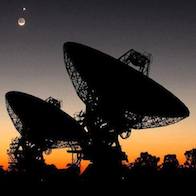 Australia Telescope - Extreme Scattering Events Survey
Australia Telescope - Extreme Scattering Events Survey
Extreme radio twinkling events are sufficiently rare that only a few examples have been studied. To address that problem we've developed a new technique for discovering extreme scattering. Rather than relying on the changes of brightness with time, which requires many observations of each source under study, we simply take a radio spectrum. Ionised gas, which causes radio twinkling, affects short and long wavelengths differently, and during extreme scattering events this leads to bizarre radio spectra as the source is in focus (bright) at some frequencies and out of focus (dim) at others. A single observation can thus tell us when a plasma lens has moved in front of a particular object, so we can simply search through a large sample of radio sources and find examples of extreme scattering even though these are rare.
This new approach has been made possible by recent advances in the electronic instrumentation used on radio telescopes. In the past, telescopes could only record narrow bands of radio-frequencies at any one time, and over small bandwidths the effect of a radio-wave lens might not be apparent. But modern, high-bandwidth electronics can provide the radio spectrum of an astronomical source over a large range of frequencies simultaneously, allowing us to recognise the influence of lensing by ionised interstellar gas.
Our new method was put into practice with the wide-band intrumentation on the Australia Telescope Compact Array — a radio telescope located near the town of Narrabri, NSW, and designed, built and operated by CSIRO. Known by the acronym "ATESE", the project sought to discover extreme scattering events while they were in progress, and to study them in detail with various techniques (radio, optical etc.).
Between April 2014 and February 2015 the ATESE project measured over 10,000 spectra of roughly 1,000 radio quasars, with varying cadence that averages to roughly once per month. Amongst these survey data we discovered a radio lensing event in the quasar PKS B1939-315, and we collected a great deal of detailed information about its properties. This is the best-studied example of any such event, ever; our data allowed us to determine the density profile of the ionised gas which caused it.
Although ATESE was designed to find long, slow lensing events, it also uncovered some instances of very fast variability, including the intra-hour variability of the quasar PKS B1322-110, situated near the bright star Spica, which led to the recognition of a relationship between hot stars and scintillators.
ATESE was a collaboration between Manly Astrophysics and CSIRO: Keith Bannister (PI), Jamie Stevens, Hayley Bignall, Cormac Reynolds, Simon Johnston .